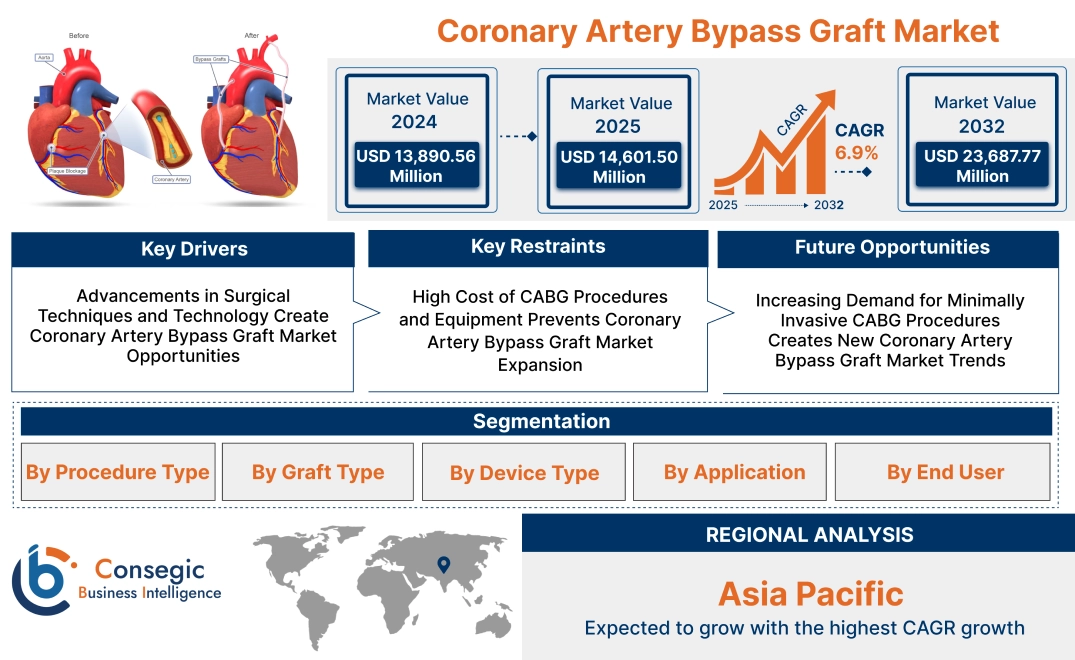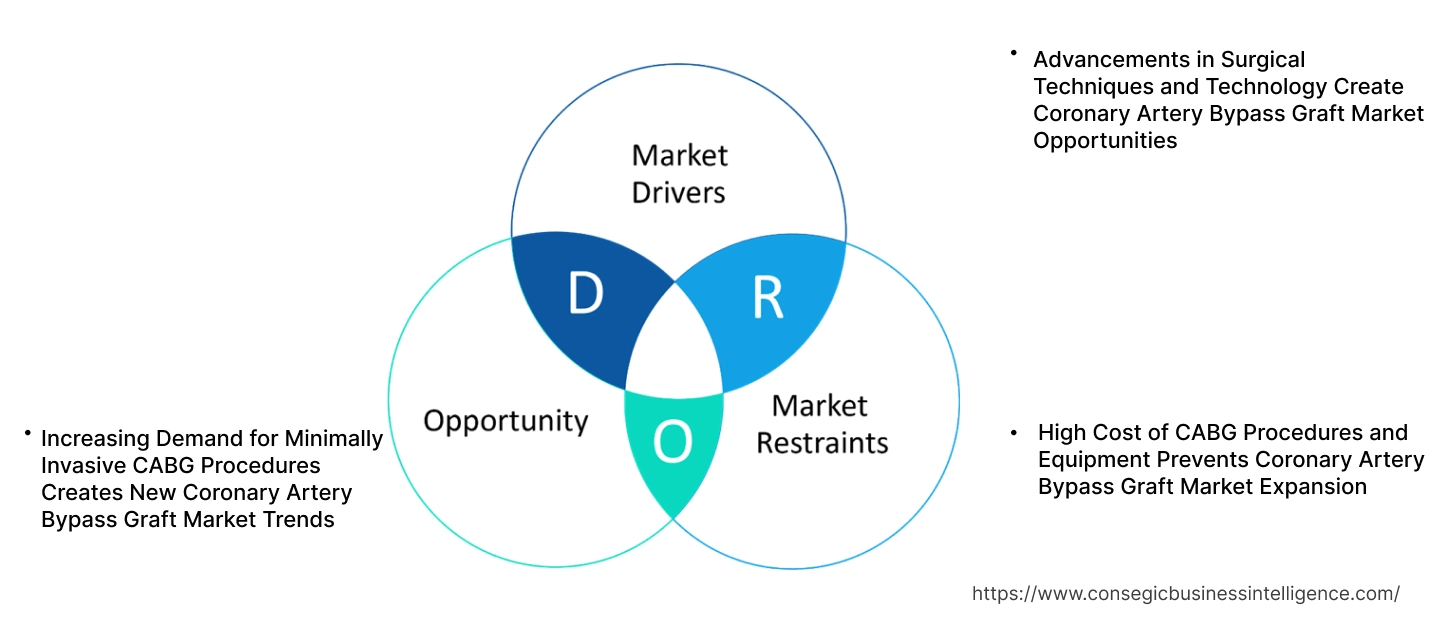Coronary Artery Bypass Graft Market Size:
Coronary Artery Bypass Graft Market size is estimated to reach over USD 23,687.77 Million by 2032 from a value of USD 13,890.56 Million in 2024 and is projected to grow by USD 14,601.50 Million in 2025, growing at a CAGR of 6.9% from 2025 to 2032.
Coronary Artery Bypass Graft Market Scope & Overview:
Coronary Artery Bypass Graft (CABG) is a surgical procedure used to treat coronary artery disease by rerouting blood flow around blocked or narrowed arteries. This procedure involves using a blood vessel from another part of the body to bypass the obstructed artery. CABG offers key benefits, including improved blood flow, enhanced heart function, and reduced chest pain. It is commonly performed in patients with severe coronary artery disease who do not respond to other treatments.
The procedure is widely used in hospitals and cardiac care centers, providing essential treatments for individuals with advanced heart disease. CABG is essential in the cardiovascular care industry, impacting both healthcare providers and patients seeking effective heart disease solutions.
Coronary Artery Bypass Graft Market Dynamics - (DRO) :
Key Drivers:
Advancements in Surgical Techniques and Technology Create Coronary Artery Bypass Graft Market Opportunities
Recent advancements in surgical techniques and technologies have significantly improved the success rates of coronary artery bypass graft (CABG) surgeries. The introduction of minimally invasive approaches, such as robotic-assisted surgery, allows for smaller incisions, reduced recovery time, and fewer complications. Additionally, innovations in grafting materials, such as the use of artificial grafts and better-quality arterial grafts, have enhanced the long-term success of CABG procedures.
For example, robotic-assisted CABG surgery has enabled precise incision placement and reduced human error, leading to faster recovery times and improved patient outcomes.
As surgical techniques continue to improve, the trend for CABG procedures is expected to increase, thereby driving the market for coronary artery bypass grafts.
Key Restraints:
High Cost of CABG Procedures and Equipment Prevents Coronary Artery Bypass Graft Market Expansion
The high cost of coronary artery bypass graft (CABG) procedures and the associated equipment remain a significant barrier to coronary artery bypass graft market growth. CABG surgeries require specialized equipment, including advanced imaging devices, heart-lung machines, and grafting tools, all of which contribute to the overall cost of the procedure. Additionally, the post-operative care and rehabilitation associated with CABG also add to the financial burden.
This high cost creates accessibility challenges, particularly for patients in low-income regions and healthcare systems with limited resources. Consequently, the high cost of CABG procedures hinders widespread adoption and affects the overall coronary artery bypass graft market growth.
Future Opportunities :
Increasing Demand for Minimally Invasive CABG Procedures Creates New Coronary Artery Bypass Graft Market Trends
The increasing preference for minimally invasive coronary artery bypass graft (CABG) procedures presents a significant opportunity for growth in the near future. Minimally invasive CABG, which involves smaller incisions and faster recovery times, is becoming more widely adopted due to its advantages over traditional open-heart surgery. With advancements in surgical technology, such as robotic-assisted surgery and improved imaging systems, minimally invasive techniques are expected to become more efficient and accessible.
For instance, as robotic-assisted CABG becomes more affordable and effective, it is expected that more hospitals and healthcare centers will offer this option to patients. This growing coronary artery bypass graft market demand for minimally invasive procedures is likely to drive the trend of the coronary artery bypass graft market in the coming years.
The focus on technological advancements, the cost-related challenges of traditional CABG, and the growing shift toward minimally invasive surgeries create a dynamic environment for the coronary artery bypass graft market's evolution.
Coronary Artery Bypass Graft Market Segmental Analysis :
By Procedure Type:
Based on procedure type, the CABG market is segmented into On-Pump CABG, Off-Pump CABG, Minimally Invasive Direct CABG (MIDCAB), and Hybrid Coronary Revascularization.
The On-Pump CABG sector accounted for the largest revenue in coronary artery bypass graft market in coronary artery bypass graft market share in 2024.
- On-Pump CABG, also known as traditional CABG, involves the use of a cardiopulmonary bypass machine to temporarily take over the role of the heart and lungs during surgery. This technique ensures a bloodless field and provides better access to coronary arteries.
- It is widely preferred for patients with multiple blocked arteries or complex coronary artery disease. The procedure is known for its long-term success rates, making it the standard choice in many clinical settings.
- Therefore, according to coronary artery bypass graft market analysis, this method offers a reliable solution for severe coronary artery diseases and continues to be the go-to choice for a large number of patients, contributing significantly to the CABG market revenue.
The Off-Pump CABG sector is anticipated to register the fastest CAGR during the forecast period.
- Off-Pump CABG, also referred to as "beating heart" surgery, avoids the use of a cardiopulmonary bypass machine, allowing the heart to continue beating during the procedure.
- This procedure is preferred for certain patient groups, particularly those with lower surgical risk, as it minimizes complications such as stroke and reduces the risk of post-operative infections.
- Thus, according to coronary artery bypass graft market analysis, with advancements in surgical techniques and technologies, off-pump CABG is gaining traction and is expected to grow rapidly due to its benefits in reducing recovery times and improving patient outcomes.
By Graft Type:
Based on graft type, the CABG market is segmented into Saphenous Vein Grafts, Internal Thoracic Artery Grafts, Radial Artery Grafts, and Other Grafts (e.g., Gastroepiploic Artery).
The Internal Thoracic Artery Grafts sector accounted for the largest revenue share in 2024.
- Internal thoracic arteries are considered the gold standard for coronary artery bypass surgery, as they are known for providing superior long-term graft patency rates.
- Surgeons prefer these grafts because of their durability and effectiveness, which significantly contribute to the long-term success of CABG procedures.
- Therefore, according to market analysis, the preference for this graft type, due to its proven benefits in bypassing coronary blockages, makes it the dominant contributor to market revenue in the CABG sector.
The Radial Artery Grafts sector is anticipated to register the fastest CAGR during the forecast period.
- Radial artery grafts are gaining popularity as an alternative to traditional grafts due to their potential for improved outcomes, especially in younger patients with more advanced coronary artery disease.
- This graft type offers excellent long-term results and is being increasingly utilized due to its superior patency rates compared to saphenous vein grafts.
- Thus, according to market analysis, as more surgical teams gain experience with radial artery grafts and technologies continue to improve, this segment is expected to expand at a rapid pace.
By Device Type:
Based on device type, the CABG market is segmented into Heart Stabilizers, Cannulas, Clamps, Retractors, Cardiopulmonary Bypass Machines, and Other Surgical Instruments.
The Cardiopulmonary Bypass Machines sector accounted for the largest revenue share in 2024.
- Cardiopulmonary bypass machines are critical for On-Pump CABG surgeries as they temporarily take over the function of the heart and lungs, allowing the surgeon to work on a still heart.
- These machines are integral to the success of On-Pump CABG procedures, contributing to the largest share of revenue in the device category.
- Therefore, according to market analysis, the growing number of surgeries using On-Pump techniques drives continued growth for advanced cardiopulmonary bypass machines, ensuring their dominance in the market.
The Heart Stabilizers sector is anticipated to register the fastest CAGR during the forecast period.
- Heart stabilizers are used in Off-Pump CABG surgeries to minimize heart movement, enabling precise anastomosis on the coronary arteries.
- As the popularity of Off-Pump procedures increases, the growth of heart stabilizers has surged due to their critical role in ensuring successful outcomes during beating heart surgeries.
- Thus, according to market analysis, innovations in heart stabilizer technologies are expected to fuel rapid growth in this segment as they become more efficient and cost-effective for use in cardiac surgeries.
By Application:
Based on application, the CABG market is segmented into Single Vessel Disease and Multivessel Disease.
The Multivessel Disease sector accounted for the largest revenue share in 2024.
- Multivessel disease is a more complex condition involving the blockage of several coronary arteries. CABG is often the preferred treatment for patients with multivessel coronary artery disease, as it provides significant improvements in long-term survival rates and quality of life.
- Therefore, according to market analysis, this segment dominates the market due to the higher prevalence of multivessel coronary artery disease, necessitating surgical interventions like CABG to restore blood flow to the heart.
The Single Vessel Disease sector is anticipated to register the fastest CAGR during the forecast period.
- Single vessel disease involves the blockage of only one coronary artery, and while it is less complex, CABG is still a viable option, particularly when stenting or angioplasty is not recommended.
- Thus, according to market analysis, as more patients with single vessel disease opt for CABG due to advancements in surgical methods, this segment is expected to grow at a rapid pace, driven by increasing awareness and the rising number of procedures.
By End-User:
Based on end-user, the CABG market is segmented into Hospitals, Ambulatory Surgical Centers, and Specialty Cardiac Centers.
The Hospitals sector accounted for the largest revenue share by 43.70%in 2024.
- Hospitals are the primary setting for CABG surgeries due to their advanced infrastructure, specialized cardiac care teams, and the ability to handle complex medical cases.
- Therefore, according to market analysis, the presence of highly skilled surgeons and the necessary equipment in hospitals makes them the dominant choice for CABG procedures, resulting in their large share of the CABG market revenue.
The Specialty Cardiac Centers sector is anticipated to register the fastest CAGR during the forecast period.
- Specialty cardiac centers offer highly focused care for heart-related conditions, including CABG surgeries. These centers typically provide personalized treatment plans and have specialized cardiac surgical teams, which can improve patient outcomes.
- Thus, according to market analysis, as the coronary artery bypass graft market trend for specialized heart care grows, specialty cardiac centers are becoming an increasingly popular choice for CABG procedures, contributing to their rapid coronary artery bypass graft market expansion.
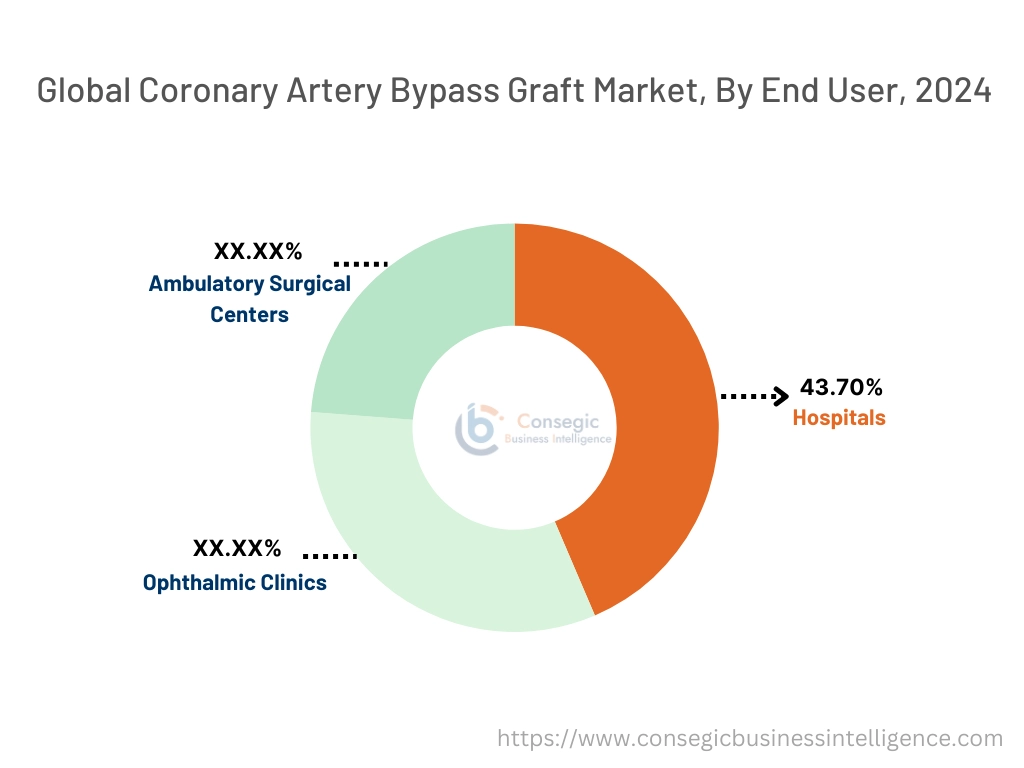
Regional Analysis:
The regional segment includes North America, Europe, Asia Pacific, Middle East and Africa, and Latin America.
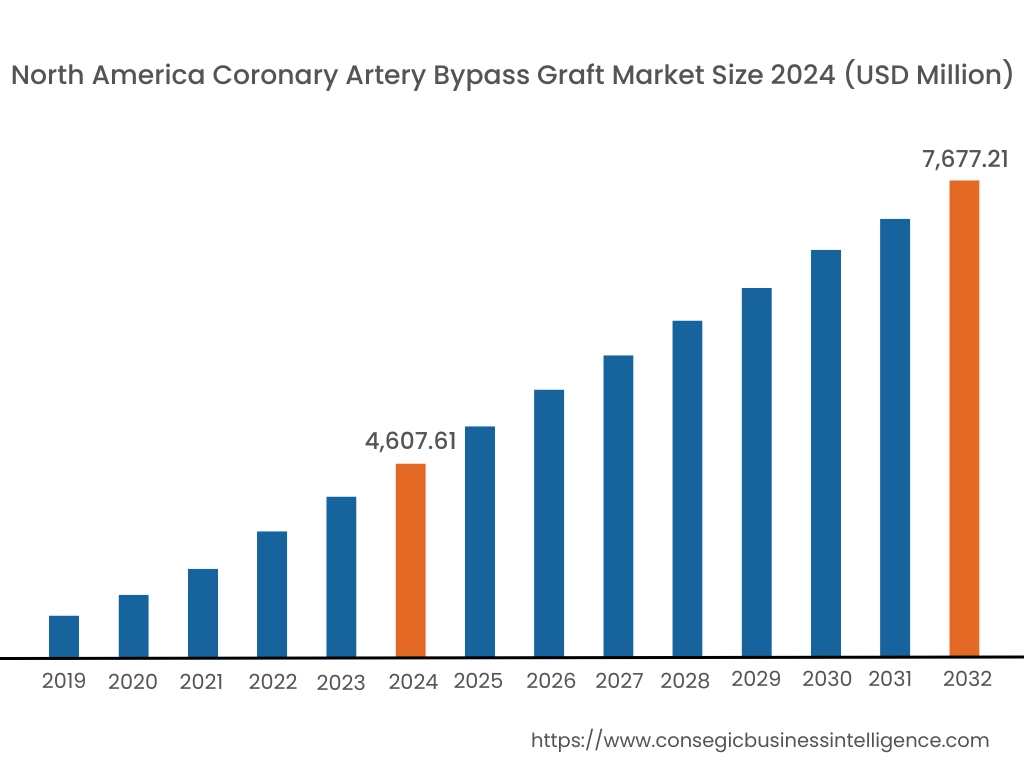
In 2024, North America was valued at USD 4,607.61Million and is expected to reach USD 7,677.21Million in 2032. In North America, the U.S. accounted for the highest share of 72.90%during the base year of 2024. North America remains the leading region in the coronary artery bypass graft (CABG) market, primarily due to advanced healthcare infrastructure and high adoption of innovative medical technologies. The United States holds a significant market share, with an aging population, increasing prevalence of cardiovascular diseases, and a high number of CABG procedures performed annually. The region benefits from extensive healthcare reimbursement systems, highly skilled healthcare professionals, and well-established hospitals, which support the demand for CABG surgeries. Research and development activities in North America also contribute to the market's trend, with continuous advancements in surgical techniques and minimally invasive procedures.
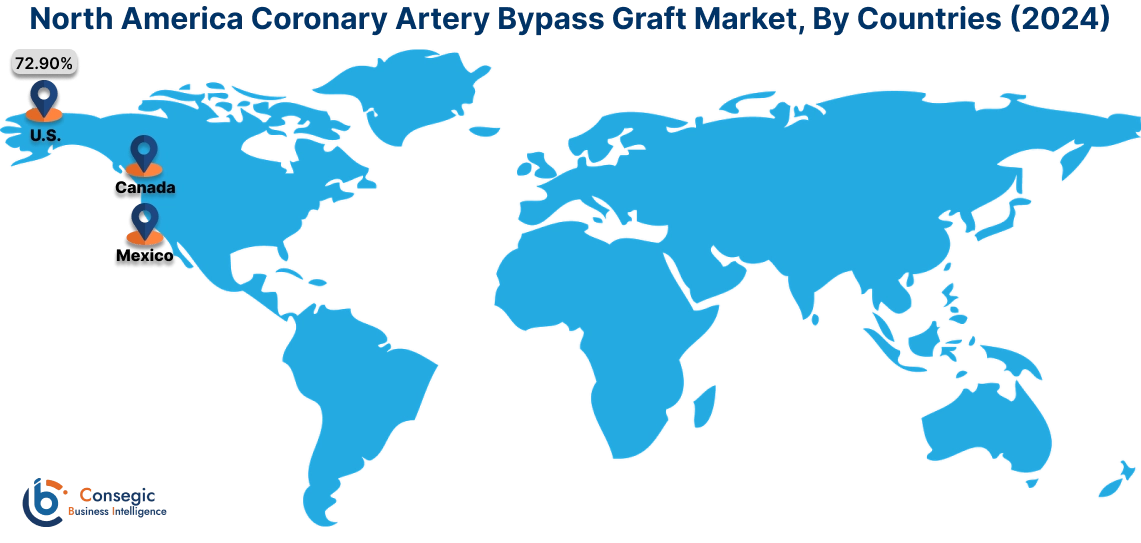
In Asia Pacific, the market is experiencing the fastest growth with a CAGR of 7.3% over the forecast period. Asia-Pacific is experiencing rapid growth in the CABG market, led by countries like Japan, China, and India. The region faces a rising burden of cardiovascular diseases due to lifestyle changes, unhealthy diets, and increasing urbanization. Japan, with its advanced healthcare system and high healthcare spending, remains one of the prominent markets for CABG procedures. In contrast, China and India are witnessing an increasing demand for CABG due to large populations and the growing prevalence of heart diseases. However, the lack of adequate healthcare infrastructure and high costs of surgery in certain areas may limit market trend in these countries.
Europe demonstrates a stable market for CABG procedures, with countries such as Germany, the United Kingdom, and France being major contributors. The region has a strong healthcare system and well-established cardiovascular care practices. The rising prevalence of cardiovascular diseases among the aging population is a key factor driving demand for CABG surgeries. Additionally, Europe's growing focus on minimally invasive surgical techniques, as well as the implementation of enhanced post-surgical care protocols, contributes to the market's performance. The European Union's healthcare policies also support the availability of CABG procedures, ensuring wider access across the region.
The Middle East and Africa (MEA) region is witnessing gradual market development, influenced by rising healthcare investments and improvements in medical infrastructure. Countries like the UAE and Saudi Arabia are investing heavily in healthcare, leading to an increased number of CABG procedures. However, in many African nations, access to CABG surgeries remains limited due to economic barriers, a lack of specialized healthcare facilities, and insufficient medical staff. Cardiovascular diseases are becoming more prevalent in the region, but healthcare systems need further trend to fully cater to the growing demand for CABG treatments.
Latin America’s CABG market is expanding as a result of increasing healthcare access and the rising prevalence of heart diseases. Brazil, Mexico, and Argentina are prominent contributors to the market due to the demand for coronary artery surgeries and improved healthcare systems. However, healthcare disparities between urban and rural areas continue to pose challenges in ensuring equal access to CABG treatments. Economic constraints in certain regions also limit the affordability and availability of advanced cardiovascular care. Despite these challenges, the market is expected to see further improvements as healthcare systems modernize and the awareness of cardiovascular diseases increases.
Top Key Players and Market Share Insights:
The Global Coronary Artery Bypass Graft Market is highly competitive with major players providing products and servicesto the national and international markets. Key players are adopting several strategies in research and development (R&D), product innovation, and end-user launches to hold a strong position in the Global Coronary Artery Bypass Graft Market. Key players in the Coronary Artery Bypass Graft industry include-
- Medtronic PLC (Ireland)
- Johnson & Johnson (United States)
- Cook Medical (United States)
- LivaNova PLC (United Kingdom)
- Baxter International Inc. (United States)
- Boston Scientific Corporation (United States)
- Stryker Corporation (United States)
- Edwards Lifesciences Corporation (United States)
- Abbott Laboratories (United States)
- Terumo Corporation (Japan)
Recent Industry Developments:
Partnerships & Collaborations
- In January 2023, Terumo collaborated with Siemens Healthineers to strengthen cardiac care in India. The partnership aims to make advanced heart care more accessible to a broader population in the region.
Coronary Artery Bypass Graft Market Report Insights :
| Report Attributes | Report Details |
| Study Timeline | 2019-2032 |
| Market Size in 2032 | USD 23,687.77 Million |
| CAGR (2025-2032) | 6.9% |
| By Procedure Type |
|
| By Graft Type |
|
| By Device Type |
|
| By Application |
|
| By End-User |
|
| By Region |
|
| Key Players |
|
| North America | U.S. Canada Mexico |
| Europe | U.K. Germany France Spain Italy Russia Benelux Rest of Europe |
| APAC | China South Korea Japan India Australia ASEAN Rest of Asia-Pacific |
| Middle East and Africa | GCC Turkey South Africa Rest of MEA |
| LATAM | Brazil Argentina Chile Rest of LATAM |
| Report Coverage |
|
Key Questions Answered in the Report
How big is the Coronary Artery Bypass Graft Market? +
In 2024, the Coronary Artery Bypass Graft Market was USD 13,890.56 million.
What will be the potential market valuation for the Coronary Artery Bypass Graft Market by 2032? +
In 2032, the market size of Coronary Artery Bypass Graft Market is expected to reach USD 23,687.77 million.
What are the segments covered in the Coronary Artery Bypass Graft Market report? +
The procedure type, graft type, device type, application, and end-user are the segments covered in this report.
Who are the major players in the Coronary Artery Bypass Graft Market? +
Medtronic PLC (Ireland), Johnson & Johnson (United States), Boston Scientific Corporation (United States), Stryker Corporation (United States), Edwards Lifesciences Corporation (United States), Abbott Laboratories (United States), Terumo Corporation (Japan), Cook Medical (United States), LivaNova PLC (United Kingdom), Baxter International Inc. (United States) are the major players in the Coronary Artery Bypass Graft market.
